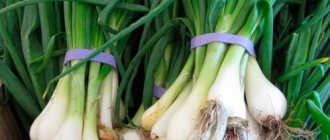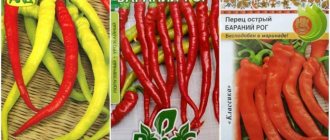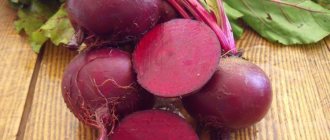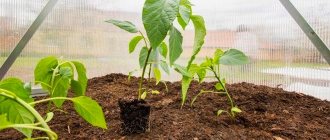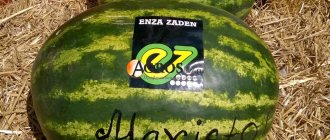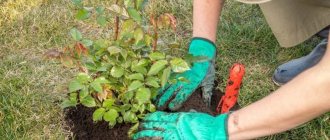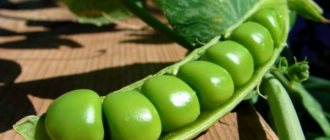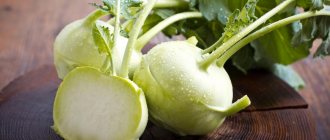To obtain a good harvest of bell pepper, it is important to create the necessary conditions for it. High humidity and elevated temperature are indicators that have a positive effect on this vegetable. But such a plant can be grown not only in warm regions. It is often found in vegetable gardens. In order for peppers to bear fruit, it is important to know how to plant peppers in open ground, what to put in the holes, as well as what the distance should be when planting peppers in open ground, and how to properly care for sweet peppers in open ground.
Seed processing technology
Growing bell peppers in open ground begins with proper seed preparation. The technology for preparing bushes for planting involves calculating the timing, because sowing must be carried out so that by the required date the pepper is ready for planting in the ground.
There are several seed treatment techniques for successfully preserving and improving planting material. With their help, you can increase guarantees for a successful harvest.
Interesting! If the seed is not processed, the seeds will sprout fourteen days after planting. When processed, the result will be visible on the third day.
First of all, it is necessary to determine which seeds are healthy. To do this, they need to be filled with a 3% solution of baking soda and water at room temperature. After five minutes, healthy seeds will remain at the bottom of the vessel, and empty and unsuitable for planting will float on the surface. After checking, the seed is washed from salt and prepared for processing.
The seed is disinfected using various solutions. This could be Albit, Fitosporin, Alirin-B or Trichodermin. You can also use your grandmother’s recipe and treat the swollen pepper seeds with a solution of potassium permanganate. 30 minutes will be enough for the treatment to produce results.
Drugs such as Ecogel, Novosil or Epin increase the plant’s immunity and accelerate its growth. They are used according to the instructions attached to them. To improve the effect, such drugs can be used after the sprouts have emerged.
In order to make the seeds strong and strong, special fertilizers are used that strengthen the seeds. To do this, just soak the seeds in diluted fertilizer for 12 hours.
Formation of a bush in a greenhouse
Pruning of this type of crop is a controversial issue. Some claim that there is no need for this and the formation of a bush only takes time without producing results. Others believe that this method will help to significantly increase the yield of bell peppers.
Since it is extremely difficult to find out the truth in this case, it is better to find your own way through your own experience. You can divide the area into two parts, pruning one and not the other.
Formation of seedlings: If you have decided to form a bush, then you should start with seedlings. When the sprout reaches 20 centimeters and the trunk begins to split into two parts.
A bud forms between the trunks, which takes a large amount of nutrients, which interferes with the development of the plant.
In order for the bush to continue to develop well and more branches to appear on which fruits will subsequently form, the bud must be removed.
The crown buds are left only if they want to get seeds. Since it is from them that you can get strong, high-quality seeds, by planting which you can get an excellent harvest.
Growing pepper seedlings
Seedlings are grown in the ground three months after sowing the seeds. Therefore, it is necessary to prepare from February. It is important to complete all the necessary procedures before starting to seed. First of all, it is necessary to process and disinfect the seeds. They are then hardened and soaked. After this they are ready to disembark.
Sowing seeds
In order for the pepper to grow faster, you must first wrap the seeds in a damp cloth and hide them in a warm place for two days. After this, you can plant them in previously prepared soil (in boxes, pots or other containers). The distance between the peppers when planting in the ground should be 1.5 cm, after which the container is covered with glass or plastic film until the seedlings emerge.
Important! To plant bell peppers, you need light soil, which consists of sand, black soil and humus. Water the seedlings with water, which is infused for one day.
It is important to regularly add organic and mineral fertilizers to the soil. The first feeding occurs after the first leaves bloom on the seedlings.
Growing pepper seedlings
You can prepare soil at home using the following ingredients:
- turf land;
- peat;
- humus;
- sawdust.
All components are mixed in a ratio of 2:4:1:1. Then ash and sand are added to the resulting soil, adhering to the following dosages: three tablespoons of ash and 0.5 liters of river sand per bucket. The resulting consistency is poured with potassium permanganate.
There are two methods to grow bell peppers:
With the help of picking
It is important to pick on time so that the plant takes root better. As soon as the seeds germinate, the vegetable grower counts 20 days and makes a pick. Since the root of the pepper does not recover well, it is not touched, but other parts of the plant are used.
Without using picks
This technique is more common. You just need to move the seedlings from a smaller container to a larger one. Then the root system is not affected and the plant takes root faster.
Growing peppers on a windowsill
When growing bell peppers on a windowsill, you need to know several subtleties and nuances. First of all, you need to choose the right time for planting seeds. Since bell peppers at home often do not have enough heat and sufficient humidity, they will take longer to germinate. Therefore, it is recommended to plant seeds in late February - early March.
For normal plant growth, it needs to be provided with 12 hours of lighting. To do this, it is enough to keep the windows constantly clean, since dirty windows take away some of the light.
Don't forget about the humidity in the room. For bell pepper it should be 70%. To do this, install an air humidifier in the room. Of course, you can spray plants with a spray bottle, but a humidifier will be more rational and safe.
For planting seeds, two-hundred-gram cups are used, which are replaced by liter cups after one month has passed after planting.
Bell pepper, cultivation and care in open ground
The technology for growing peppers in open ground is similar to growing tomatoes. It is important to water the plant on time, feed it, shape it, and, if necessary, remove the stepsons. Don’t forget about protection from various pests and diseases.
It is necessary to water sweet peppers as soon as they are planted in open ground, then after five days. After each watering, it is necessary to loosen the soil so that there is no hardened soil. The plant is fed three times per season. For this purpose, nitrogen, potassium and phosphorus are used.
Don't forget about protection from heat. To prevent pollen from losing its abilities, it is necessary to make screens that will darken the plant.
You may be interested in: Favorable days for picking pepper in 2021 according to the lunar calendar Favorable days for planting pepper for seedlings in 2021: terms and rules for sowing at home Favorable days for sowing sweet and bitter pepper for seedlings in 2021
After what crops should pepper be planted?
Peppers should be planted in beds after those plants that are not affected by the same diseases as crops of the nightshade family. Therefore, the best predecessors are legumes and any greens, root vegetables (carrots, beets), squash, zucchini and pumpkin, cucumbers and any kind of cabbage.
You cannot plant peppers after potatoes, eggplants, tomatoes and strawberries. Despite the fact that strawberries are not classified as nightshades, these crops are often affected by one type of fungus.
Peppers are very fond of spider mites and other pests, so it is recommended to plant garlic and onions, marigolds and nasturtiums, coriander and calendula next to them. These plants secrete phytoncides that repel pests. Carrots have the same property, which can be planted along the edge of a vegetable bed.
You will be interested to know: Planting peppers for seedlings in February: when to plant according to the Lunar calendar, how to prepare the seeds
Bell pepper, grown in a barrel
You can also grow the crop in a barrel. To do this, you need to take a barrel and remove the bottom. In order for oxygen to enter the barrel, holes must be made in its walls, 1 cm in diameter at a distance of 20 cm from each other.
Then the following components are laid out in layers: fading (layer thickness 10 cm), soil mixture (turf and ordinary soil, compost).
At the beginning of May, one pepper bush is planted and covered with film. After three hours, tear off all the lower leaves and fill the plant with 10 cm of soil mixture. After the plant grows, repeat the procedure. Do this until the barrel is completely filled with earth (this will be the beginning of June). Then the barrel can no longer be covered with film.
Features of agricultural technology
Agricultural technology for growing sweet peppers in open ground consists of the following processes:
- Irrigation. Seedlings must be watered with settled water every day. You need to be careful not to overdo it with water.
- Prevention. Periodically spray the plants with a spray bottle to maintain moisture.
- Temperature. It should not exceed 22°C during the day and 15°C at night.
- Feeding. To increase the immunity of pepper, it is necessary to feed it with minerals.
Landing dates
Seedlings planted in cold soil may die, so you should wait for warm weather and plant the peppers in open ground, which at the planting depth has warmed up to +12..+15 degrees. Also, the threat of night frosts should have passed.
Rooted seedlings can withstand fairly low temperatures for a short time, but if frosts are expected and the seedlings have just been planted, then you need to build a greenhouse and cover it with film or non-woven material. Peppers grown in low temperatures will not grow and are more likely to develop diseases.
In Siberia, the Urals and other areas with not very warm springs, it is recommended to plant peppers in open ground in early June. In warmer regions (for example, in the Moscow region), planting can be done in May, depending on the weather.
By the time of planting, the seedlings must be more than 50-60 days old, have strong internodes, at least 9-12 leaves and one or more buds. Overgrown seedlings do not take root well and grow slowly.
Principles of growing on site
Sweet pepper is a plant that requires care and attention. Therefore, an experienced gardener prepares in advance all the necessary tools to care for it. Outdoor care for sweet peppers consists of the following steps:
- seedling preparation;
- planting a plant in the ground;
- watering;
- feeding
Preparation of bushes
Before planting seedlings in open ground, they must be hardened off. To do this, the plant must be periodically exposed to the sun to adapt. Due to this, the pepper will be resistant to weather conditions and will be strong. Hardening begins two weeks before planting.
The process of planting plants in open soil
To get a good pepper harvest, you need to choose the right place for the beds. This area should not be exposed to direct wind currents, be sunny and protected from drafts. In the fall, it is important to prepare the necessary area for planting by first digging it up and fertilizing it. It is necessary to plant bell peppers in open ground by impregnating the soil with potassium and phosphorus substances.
When planting, it is important to remember that sweet peppers do not like direct sunlight and too hot air. Therefore, it is necessary to ensure that the seedlings are in the shade.
Depending on which variety is planted, a scheme for planting bell peppers in open ground is developed. The holes should be 35 cm apart from each other, and 45 cm between the rows. If two peppers are planted in the ground, then the distance increases to 60 cm.
There is also a square-cluster method of planting peppers. Its essence is that each hole has identical sides that do not exceed 60 cm.
Peppers are transplanted into the ground at the end of spring or early June, depending on weather conditions. It is recommended to do this on a cloudy day or in the late afternoon, so that there is no direct rays of the sun on the ground.
Planting pepper in open ground begins with the seedlings first being watered and carefully, without damaging the root of the plant, removed from the container along with a lump of soil. At the same time, it is important to know at what depth it is necessary to plant pepper seedlings in the hole. The stem of the plant is placed underground up to its first lower leaves. After planting sweet peppers in open ground has been completed, it is recommended to insert pegs nearby to which they will be tied in the future.
Features of watering
Bell peppers do not require regular watering and moistening of the open ground. Initially, it must be watered during planting, then after 5 days and then once a week. Approximately one liter of water is needed for one pepper bush.
During flowering, water for irrigation should be about 20°C. Don’t forget to loosen the soil around the bush after each watering to prevent a crust from forming. To keep moisture longer, it is recommended to mulch bell peppers. Mulching peppers in open ground is done using rotted straw or grass.
Pepper feeding
It is necessary to fertilize the soil three times throughout the entire season. In order for plants to develop and grow normally, they need nitrogen. Therefore, the first feeding is preparations containing nitrogen. It is done 2 weeks after planting the bushes in the ground.
The next feeding is carried out during the flowering period of pepper. The plant needs potassium to form fruits. It is found in wood ash. And the last feeding occurs when the first fruit has formed. For this, potassium salt and superphosphate are used. Two teaspoons of each component are added to a bucket of water and the plants are watered with the resulting solution.
Preparation and hardening
Before planting seedlings, they must be prepared for changing conditions. Transplantation is performed after hardening - a deliberate decrease in air temperature in order to increase the adaptability of plants.
The experience of gardeners shows that “chilled” bell pepper seedlings take root successfully, the stems of the seedlings become more powerful, and the internodes are short and fibrous.
Hardening is carried out with caution, without haste - a sharp decrease in temperature can harm fragile heat-loving plants.
Recommended scheme:
- Hardening begins when the daytime temperature reaches +12°C. The first “exit” of seedlings is for 2-3 hours. The container with seedlings is placed outside in a windless place.
- The second day of hardening is 4-6 hours in the fresh air.
- Third day – up to 10 o’clock. In warm weather, the seedlings are left to “walk” all day, bringing them home at night.
- The fourth day is hardening in day/night mode, but with obligatory shelter at night.
Important! The minimum hardening period is 3 days. To increase the viability of seedlings, planned cooling is recommended to begin 1-2 weeks before transplanting to a permanent location.
In addition to hardening, before planting pepper seedlings in the ground, you must:
- 10-11 days after transplantation, reduce the intensity of watering; within a week, eliminate it completely.
- On the eve of planting, but not earlier than 24 hours, provide abundant watering by adding potassium chloride.
- If seedlings are to be transported, watering and fertilizing are carried out two days in advance. Stems filled with water become more fragile and are easily damaged.
- It is better to remove buds formed before transplantation. This will stimulate active flowering and fruit formation.
What to do if pepper seedlings bloom before the transplant date? Primroses must be torn off, and the temperature regime for growing future seedlings must be reduced to 15°C - this will slow down the growth process. The summer resident will gain some time until the air and soil warm up.
Tip: If seedlings are cultivated in a snail, then the plants need additional lighting so that the stems do not stretch too much. In addition, when growing in a snail, it is advisable to periodically add soil to the seedlings - this promotes the formation of additional roots.
Possible diseases and pests and their control
The following pests can often be observed on pepper:
- aphid;
- slugs;
- Colorado beetle;
- whitefly;
- bear
These pests are collected by hand, and a solution of wood ash is used for aphids.
Popular diseases are:
- Yellowing of leaves. This means the pepper is lacking nitrogen. For treatment, you need to add 1 teaspoon of urea to 10 liters of water and spray the bushes with the resulting solution.
- Falling of the ovaries. A solution of boric acid will solve the problem (1 spoon per bucket of water).
- Fruits develop poorly. Treated with superphosphate or wood ash.
- Blackleg. Occurs from excess moisture.
Growing greenhouse peppers
Planting a crop in open ground under a film is considered the most convenient, as it brings the crop closer to normal conditions. Seedlings can be planted in the greenhouse in April. To do this, holes are made in the greenhouse, maintaining the correct distance.
Before planting seedlings, it is important to fertilize the hole. A solution based on chicken droppings or manure is perfect for this (half a glass of fertilizer per 10 liters of water). After planting, the bushes are watered at a rate of 1 liter per bush. And to support the plant, you can make a support from pegs, so that you can then tie the pepper to it.
Top dressing
Many gardeners wonder what to feed peppers after planting in a greenhouse and during the period of active growth of the bush. There are several stages of introducing fertilizers:
- 3-4 weeks after planting the seedlings in the greenhouse. Superphosphate 5 grams mixed with water 10 liters and urea 10 grams is suitable. Pour 1 liter of solution under each bush.
- During the flowering period. Use a mixture of superphosphate (9-10 grams), potassium sulfate - 3 grams, water - 10 liters. Fertilize each bush with 1 liter of solution.
- Harvesting. Mix phosphorus 1 tsp. and potassium 1 tsp. with 10 liras of water. 1 liter of solution is poured under each root.
Feeding requires a competent approach. Do not use chicken manure or cattle manure. They can burn the root system, disrupt metabolism, which will lead to a decrease in yield and leaf growth.
Collection and storage
Bell peppers are harvested as the fruits ripen. Some vegetable growers may collect unripe fruits to remove the weight from the bush. This vegetable is used in many recipes, fried, stewed or baked. The fruits can be peeled and frozen or canned.
In order to receive fresh peppers until December, you can transplant the flowering bush along with the soil into any container and leave it on the windowsill in the house.

